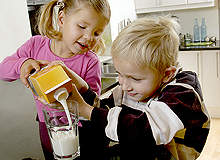
Dairy has complex sustainability issues that boggle the minds of experts, let alone the companies that want to serve the “cream” of the dairy brands.
In particular, suitable packaging for sensitive, chilled or ambient milk-based goods can be difficult to come by. It has to be environmentally friendly, economic and sensitive to social issues, while the impact of raw materials must be traceable; back to forestry for paper packaging, fossil-based oil for plastics and furnaces for glass.
There are no shortcuts to winning customers, supplier support and respect from the investor community. Elopak’s Sveinar Kildal knows this all too well: he is the director responsible for environmental issues across more than 80 global markets.
Special challenge
The emerging consensus among packaging producers and users is that total lifecycle assessment is a fairer way to evaluate the impact of what we produce and consume. The special challenge for the dairy sector, Kildal believes, will be managing the CO2 component in agricultural production.
lifecycle assessment is
a fairer way to evaluate the impact of what we produce
and consume.”
He praises the substantial work that has already been done to rein in this environmental impact by producers such as Arla Foods, whose brands include Cravendale, Anchor and Lurpak, but adds that packaging suppliers have a responsibility to do the same. That could be by reducing material and energy use, or engaging the supply chain so the benefits can be seen across all company and brand activities.
"Elopak has taken full supply chain responsibility," Kildal reveals. The manufacturer is also a full member of the Carbon Disclosure Project (CDP), which publishes the greenhouse gas emissions of major corporations. Elopak plans to earn a high CDP rating by linking up with its suppliers to innovate to reduce carbon.
"We’ve been a CDP respondent for a long time because our customers are members. Now we are asking our suppliers to become respondents themselves so we can disclose their carbon impact as well."
This goes beyond the large companies that, in many cases, are well resourced and likely to have taken an active part in the carbon “discover and disclose” process early on.
"Small, local dairies are important customers to us too, and we want to give them knowledge and competence," he adds. "It is complicated stuff to understand and it is costly for smaller companies to employ lifecycle assessment experts."
Going beyond the obvious
us too, and
we want to
give them
knowledge and competence.”
Some of the issues Elopak must touch on go beyond the realm of packaging. How food crops are produced, fertilizers are used and the way products are manufactured can all have an impact on sustainability. Within packaging, cost, renewably sourced bioplastics and land use can be thorny issues. For example, in the composite carton, fossil-based barrier plastics are exclusively used, although Elopak is researching into alternative bioplastics.
"We have not succeeded in developing a commercially viable process yet," Kildal says. "The challenge is to find new materials that are sustainable in volume. There is an acceptable barrier to oxygen transmission, but it’s expensive. A company has to make money; it has to survive."
He anticipates that second-generation bioplastics, based on cellulose (from wood), will help avoid land competition issues. Elopak puts back about 6-7% of its turnover into research and development. This year it managed to reduce material use by 7% with the cooperation of Stora Enso, its main dairy market supplier for paperboard.
This article first appeared on our sister site, Packaging Today.



